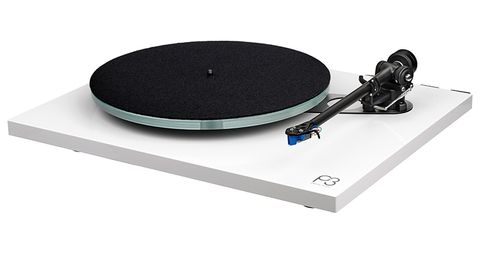The Pioneer PL-12D revolutionized the industry. It was at this point that established British companies like BSR and Garrard were deprived of their core market — entry-level turntables. Suddenly, in 1973, you could get a significantly slicker belt drive deck with Japanese build quality for a few pounds more than a clumsy, idler drive Garrard SP25 MK IV. Naturally, the PL-12 became an instant hit, but Pioneer’s competitors weren’t going to let them have all the fun forever…
Kenwood, or Trio as it was called in the United Kingdom, responded with the KD-1033. It was essentially a carbon replica of the PL-12D, albeit slightly better. It had an independently sprung subchassis that sat on leaf springs in a small, light vinyl-wrapped chipboard plinth that measured 456x347x145mm and came with a smoked plastic dustcover. A 4-pole synchronous motor turned a light, diecast zinc alloy platter – topped with a soft rubber mat – via a square section belt in a two-speed configuration. At the price, speed stability was good; 0.06 percent WRMS. Wow and flutter were significantly superior to the Garrard, and it was also quieter with a signal-to-noise ratio of (better than) 48dB. This was a point-for-point battle with the PL-12.
The Trio’s J-shaped stainless steel tonearm, on the other hand, was marginally better; it followed cartridges up to 3g and could just about run reliably at half that. This was pure exotica compared to the SP25’s industrial-feeling straight tube pick-up arm, which was happy between 2.5g and 5g. The Trio’s 215mm (effective length) arm was a league better than the Garrard’s, and had significantly less friction. The best part was that it was only good enough to be termed true hi-fi, which was all most customers cared about.
It had an advantage over the Pioneer in terms of slickness and ease of use. It also had a cleaner, more modern appearance. The controls were light to the touch, the deck clicked crisply between 33 and 45 RPM, and there was an overall sense of firmness and accuracy that the market had not seen before. It was strong enough to withstand auditory feedback, and the deck’s responsive springing made it slightly more resistant to environmental vibrations than its competitors.
The KD-1033 sounded delicious, smooth, stable, civilized, and sophisticated. You wouldn’t describe it as punchy or dynamic, but it did deliver a mature sound that people had never heard from a £50 turntable before. It sounded a little more open and airy than the PL-12, but the differences weren’t significant. Although vinyl fanatics of the day frequently replaced the original, resonant aluminium version with an ADC magnesium one relatively sharpish, the B version of 1976 added a little better mat and headshell. It was a great seller, and it ruled the budget turntable roost in the UK from roughly 1977 until the Dual CS506 arrived in 1980.
Because they were significant sellers and have lasted the test of time well, there are still plenty of Trio KD-1033s on the market today. Most are equipped with Shure M75s, Ortofon FF15Es, Grado FTEs, or Audio-Technica AT-95s or 110s, which are all excellent match. The aforementioned AT-95E, which is still available new for under £30, is a nice current cartridge option. The ‘B’ suffix, by the way, refers for black finish; there was also a silver-finished ‘S’ version that sold better towards the deck’s end of existence. KD-1033s can range in price from £50 to £100 depending on condition and provenance; as a beginner turntable, you can’t go wrong with one, so keep a watch out!







